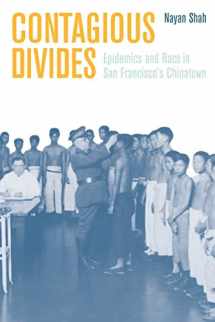
Contagious Divides: Epidemics and Race in San Francisco's Chinatown (American Crossroads) (Volume 7)
ISBN-13:
9780520226296
ISBN-10:
0520226291
Edition:
First Edition
Author:
Nayan Shah
Publication date:
2001
Publisher:
University of California Press
Format:
Paperback
384 pages
FREE US shipping
on ALL non-marketplace orders
Marketplace
from $15.00
USD
Marketplace offers
Seller
Condition
Note
Seller
Condition
Used - Very Good
Very Good; Very good paperback from a personal collection (NOT ex-library). Spine is uncreased, binding tight and sturdy; exterior shelfwear is very minor. Text is also very good and interior appears free of markings. Ships same or next day from Dinkytown, Minneapolis, Minnesota.
Book details
ISBN-13:
9780520226296
ISBN-10:
0520226291
Edition:
First Edition
Author:
Nayan Shah
Publication date:
2001
Publisher:
University of California Press
Format:
Paperback
384 pages
Summary
Contagious Divides: Epidemics and Race in San Francisco's Chinatown (American Crossroads) (Volume 7) (ISBN-13: 9780520226296 and ISBN-10: 0520226291), written by authors
Nayan Shah, was published by University of California Press in 2001.
With an overall rating of 3.8 stars, it's a notable title among other
State & Local
(United States History, Health Policy, Administration & Medicine Economics, Americas History) books. You can easily purchase or rent Contagious Divides: Epidemics and Race in San Francisco's Chinatown (American Crossroads) (Volume 7) (Paperback, Used) from BooksRun,
along with many other new and used
State & Local
books
and textbooks.
And, if you're looking to sell your copy, our current buyback offer is $1.8.
Description
Contagious Divides charts the dynamic transformation of representations of Chinese immigrants from medical menace in the nineteenth century to model citizen in the mid-twentieth century. Examining the cultural politics of public health and Chinese immigration in San Francisco, this book looks at the history of racial formation in the U.S. by focusing on the development of public health bureaucracies.
Nayan Shah notes how the production of Chinese difference and white, heterosexual norms in public health policy affected social lives, politics, and cultural expression. Public health authorities depicted Chinese immigrants as filthy and diseased, as the carriers of such incurable afflictions as smallpox, syphilis, and bubonic plague. This resulted in the vociferous enforcement of sanitary regulations on the Chinese community. But the authorities did more than demon-ize the Chinese; they also marshaled civic resources that promoted sewer construction, vaccination programs, and public health management.
Shah shows how Chinese Americans responded to health regulations and allegations with persuasive political speeches, lawsuits, boycotts, violent protests, and poems. Chinese American activists drew upon public health strategies in their advocacy for health services and public housing. Adroitly employing discourses of race and health, these activists argued that Chinese Americans were worthy and deserving of sharing in the resources of American society.
Nayan Shah notes how the production of Chinese difference and white, heterosexual norms in public health policy affected social lives, politics, and cultural expression. Public health authorities depicted Chinese immigrants as filthy and diseased, as the carriers of such incurable afflictions as smallpox, syphilis, and bubonic plague. This resulted in the vociferous enforcement of sanitary regulations on the Chinese community. But the authorities did more than demon-ize the Chinese; they also marshaled civic resources that promoted sewer construction, vaccination programs, and public health management.
Shah shows how Chinese Americans responded to health regulations and allegations with persuasive political speeches, lawsuits, boycotts, violent protests, and poems. Chinese American activists drew upon public health strategies in their advocacy for health services and public housing. Adroitly employing discourses of race and health, these activists argued that Chinese Americans were worthy and deserving of sharing in the resources of American society.


We would LOVE it if you could help us and other readers by reviewing the book
Book review

Congratulations! We have received your book review.
{user}
{createdAt}
by {truncated_author}




